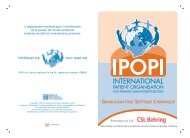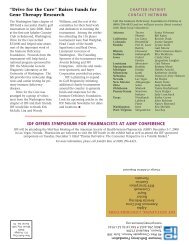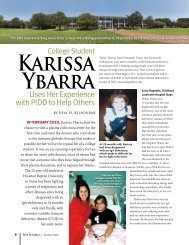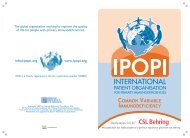IDF Patient & Family Handbook for Primary Immunodeficiency ... - IDFA
IDF Patient & Family Handbook for Primary Immunodeficiency ... - IDFA
IDF Patient & Family Handbook for Primary Immunodeficiency ... - IDFA
Create successful ePaper yourself
Turn your PDF publications into a flip-book with our unique Google optimized e-Paper software.
Severe Combined <strong>Immunodeficiency</strong><br />
27<br />
Diagnosis of Severe Combined <strong>Immunodeficiency</strong> continued<br />
The diagnosis of SCID can also be made in<br />
utero (be<strong>for</strong>e the baby is born) if there has been<br />
a previously affected infant in the family and<br />
if the molecular defect has been identified. If<br />
mutational analysis had been completed on the<br />
previously affected infant, a diagnosis can be<br />
determined <strong>for</strong> the conceptus (an embryo or fetus<br />
with surrounding tissues). This can be done by<br />
molecular testing of cells from a chorionic villous<br />
sampling (CVS) or from an amniocentesis, where<br />
a small amount of fluid (which contains fetal<br />
cells) is removed from the uterine cavity. Even<br />
if the molecular abnormality has not been fully<br />
characterized in the family, there are tests that can<br />
rule out certain defects. For example, adenosine<br />
deaminase deficiency can be ruled in or out by<br />
enzyme analyses on the above-mentioned CVS<br />
or amnion cells. If there is documentation that the<br />
<strong>for</strong>m of SCID is inherited as an X-linked recessive<br />
trait and the conceptus is a female, she would not<br />
be affected.<br />
In a majority of cases, unless termination of the<br />
pregnancy is a consideration if the fetus is affected,<br />
the diagnosis is best made at birth on cord blood<br />
lymphocytes. This is because there is some risk<br />
to the fetus by the above procedures if blood is<br />
collected <strong>for</strong> lymphocyte studies while he or she is<br />
in utero.<br />
Early diagnosis, be<strong>for</strong>e the infant has had a<br />
chance to develop any infections, is extremely<br />
valuable since bone marrow transplants given in<br />
the first 3 months of life have a 96% success rate.<br />
In fact, screening all newborns to detect SCID<br />
soon after birth is technically possible because of<br />
recent scientific advances. In fact, pilot programs<br />
to test the feasibility of newborn screening in<br />
all infants are planned. If simple screening tests<br />
were done on the cord blood of all babies born in<br />
the United States, all infants with SCID could be<br />
diagnosed at birth and transplantation could be<br />
accomplished shortly after that with expectation of<br />
a greater than 96% success rate.<br />
Inheritance of Severe Combined<br />
<strong>Immunodeficiency</strong><br />
All types of SCID are probably due to genetic<br />
defects. These defects can be inherited from the<br />
parents or can be due to new mutations that arise<br />
in the affected infant. As already noted, the defect<br />
can be inherited either as an X-linked (sex-linked)<br />
defect where the gene is inherited from the mother<br />
or as one of multiple types of autosomal recessive<br />
defects (see previous section on the causes SCID)<br />
where both parents carry a defective gene. The<br />
reader should turn to the chapter titled Inheritance<br />
to more fully understand how autosomal recessive<br />
and sex-linked recessive diseases are inherited,<br />
the risks <strong>for</strong> having other children with the disease<br />
and how these patterns of inheritance affect other<br />
family members. Parents should seek genetic<br />
counseling so that they are aware of the risks of<br />
future pregnancies.<br />
It should be emphasized that there is no right<br />
or wrong decision about having more children.<br />
The decision must be made in light of the special<br />
factors involved in the family structure, the basic<br />
philosophy of the parents, their religious beliefs<br />
and background, their perception of the impact of<br />
the illness upon their lives, and the lives of all the<br />
members of the family. There are countless factors<br />
that may be different <strong>for</strong> each family.
















